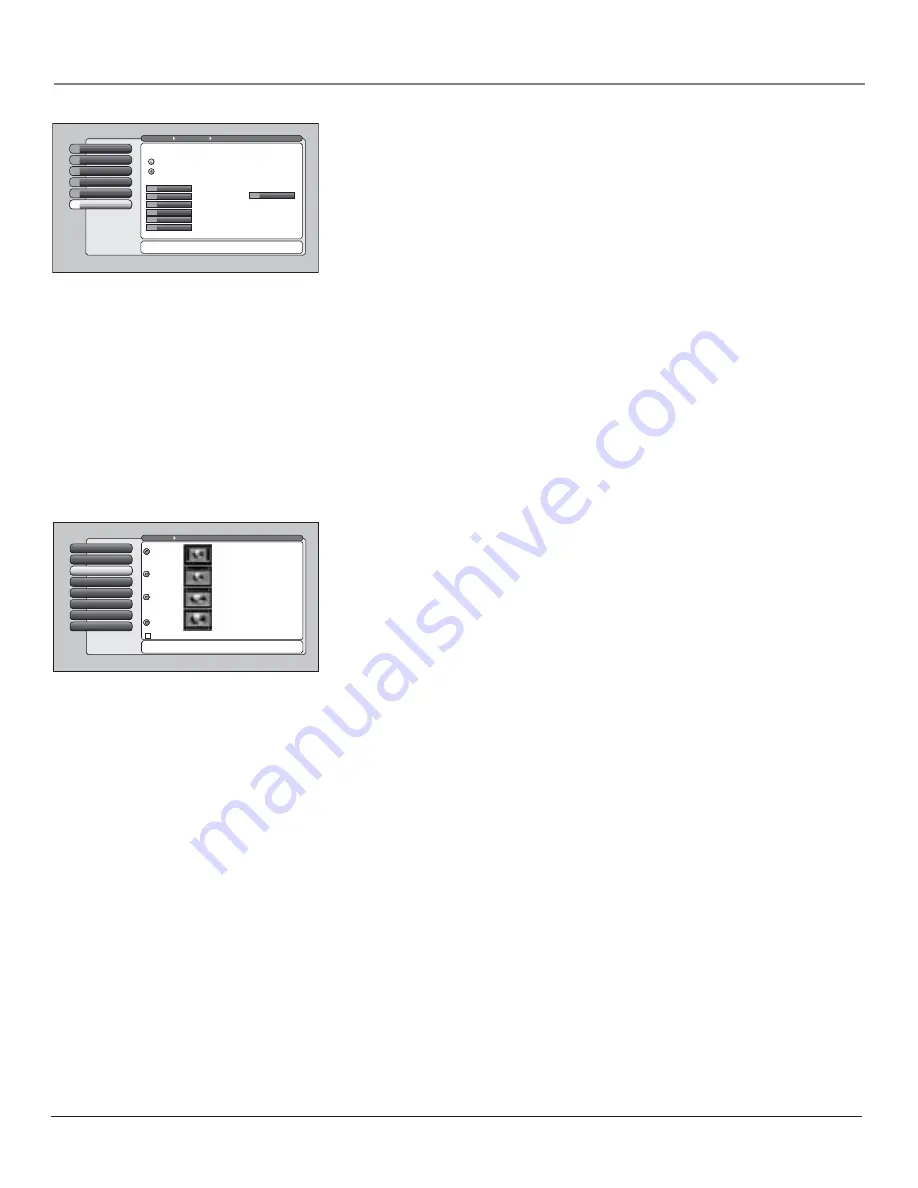
Chapter 4
61
Using the TV’s Menu System
Menu Language
6
Lamp Power
7
Translucency
5
Color Scheme
4
Time Menu
3
Screen Format
Screen Format
2
Closed Captioning
1
Go Back
0
Main Menu
Preferences
Screen format determines the format and size of the
picture on the display screen. Press OK to continue.
Use this screen or the FORMAT
button on the remote to change
how the picture is displayed.
To the left are examples of the
effect of different Screen
Format modes on a 4:3 signal.
Each input can have a different
setting for Screen Format and
Automatic Format Switching
(AFS). Enabling AFS shows
the picture in a suitable format,
otherwise, the default Screen
Format that you selected is used.
Zoom
Stretch
Normal
Cinerama
Use Automatic Format Switching
Caption Style
Customize closed captioning for the digital captions by choosing the settings for
the following options:
Caption Size
is the font size (
Standard, Large, Small
) of the text
characters.
Caption Font
is a complete assortment of letters, numbers, punctuation
marks, etc. of a given font design. You have eight fonts with varying styles
of spacing from which to choose.
Note:
A preview graphic of the caption font appears on the right of the screen.
Caption Color
allows you to choose the font color:
White, Black, Red,
Green, Blue, Yellow, Magenta,
and
Cyan
.
Background Color
allows you to choose the background color:
White,
Black, Red, Green, Blue, Yellow, Magenta,
and
Cyan
.
Background Opacity
allows you to change the see-through background
options:
Solid, Transparent, Translucent,
and
Flashing.
Caption Opacity
allows you to change the see-through caption options:
Solid, Transparent, Translucent,
and
Flashing.
Screen Format
The
Screen Format
feature allows you to change how the image of a 4:3 picture
is displayed on your 16:9 screen. The options are
Normal, Cinerama, Zoom
or
Stretch
. If your TV receives an image with a 4:3 aspect ratio, the image can be
displayed in one of four ways:
Normal
The image of a 4:3 video signal is centered with bars on the right
and left sides of the screen.
Cinerama
The image of a 4:3 video signal is centered, expanding in the
horizontal direction to fill the display with little distortion.
Stretch
The image of a 4:3 video signal is stretched horizontally by
approximately 33% while the vertical size stays the same.
Zoom
The image of a 4:3 video signal increases by approximately 33%
and the vertical size increases by approximately 33%. Edges of the image
might be cropped.
Note:
When recording from the AUDIO/VIDEO OUTPUT jacks, use
Normal or Stretch to record the video closest to its original format.
Turn on
Automatic Format Switching
so that as you change channels, the TV
will change formats for you.
Notes:
There is no ability provided to change the screen format for a
16:9 video signal since it fills up the entire area of the TV’s screen.
The format of some video cannot be changed even though it appears to
be a 4:3 aspect-ratio picture.
The FORMAT button on the remote lets you change the format with a
one-button press rather than navigating to the
Screen Format
menu.
Caption Style
Caption Style
5
Caption Priority
4
Digital Captions
3
Analog Captions
2
Caption Display
1
Go Back
0
Main Menu
Preferences
Closed Captioning
Press OK to select one of the three Caption sizes. Press
to
return to the menu.
When available digital captions can be displayed using:
The caption provider's default settings.
Your custom settings below.
Translucent
Caption Opacity
Aa Bb Cc
Transparent
Background Opacity
Yellow
Background Color
Magenta
Caption Color
Font 1
Caption Font
Standard
Caption Size






























